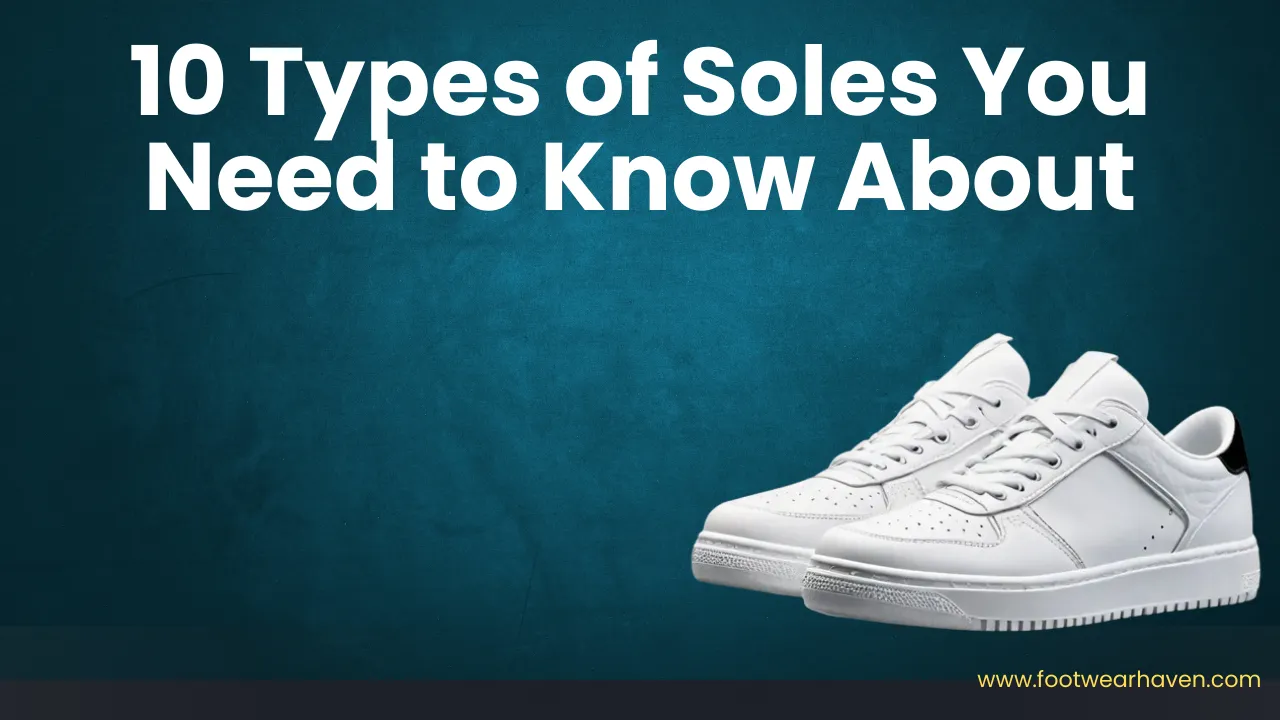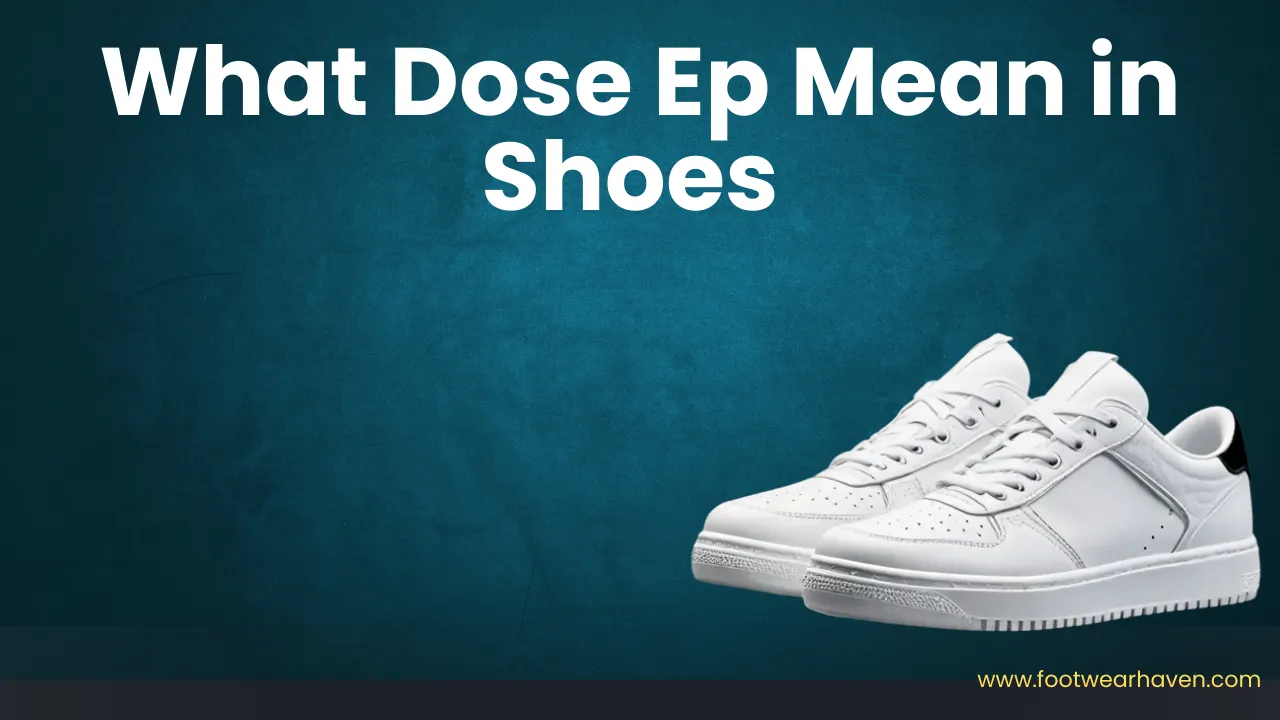Understanding the different types of soles is crucial when selecting shoes that cater to your comfort, durability, and performance requirements. From leather and rubber to modern materials like EVA and TPU, each sole type offers unique benefits for specific uses.
Additionally, innovations such as EP in shoes (Engineered Performance) have transformed how soles are designed, offering better traction, flexibility, and long-term support. This guide breaks down the most common sole types to help you make the right footwear choice for your lifestyle or activity.
Table of Contents
Toggle10 Different Types of Soles Used in Shoes

Below are the 10 most common types of soles used in footwear today. Each material offers distinct advantages in terms of durability, comfort, and purpose—helping you choose the right pair for your needs.
1. Genuine Leather Shoe Soles
Genuine leather, derived from animal hide through tanning, is a premium material commonly found in dress shoes, high-end casual shoes, and leather boots.
Features
- Natural Texture: The natural grain and texture of animal hide give it a luxurious and sophisticated look.
- Breathability: The microscopic pores in leather allow airflow, keeping feet cool and dry.
- Durability: Tanned leather is long-lasting and highly resistant to wear and tear.
Drawbacks
Genuine leather is a high-cost material that requires regular maintenance. It is also unsuitable for wet conditions.
2. PU Shoe Soles
PU, or polyurethane, is a synthetic material known for its durability and abrasion resistance, making it ideal for work shoes and boots.
Features
- High Abrasion Resistance: PU has a hard surface and a stable structure, making it resistant to wear.
- Waterproofing: Its dense surface offers excellent waterproof capabilities, making it great for outdoor use.
Drawbacks
The production process of PU is labor-intensive, making it pricier. It also offers limited breathability, leading to reduced comfort for prolonged wear.
3. PVC Shoe Soles
PVC, a polymer obtained from vinyl chloride, is often used for rain boots, work shoes, and budget fashion shoes due to its low cost and mass production suitability.
Features
- Low Cost: Ideal for mass production due to its affordability.
- Waterproof: Strong resistance to water makes it suitable for wet environments.
- Wear-Resistant: It can endure harsh conditions and resist corrosion.
Drawbacks
PVC has poor slip resistance, posing a safety risk in high-friction areas. It is also hard, lacks breathability, and becomes brittle in cold weather.
4. Artificial Leather Shoe Soles
Artificial leather, made by synthesizing PVC and PU, mimics natural leather. It’s often used in fashion shoes, sneakers, and budget-friendly footwear.
Features
- Cost-Effective: More affordable than genuine leather, suitable for large-scale production.
- Variety: Available in many textures and colors to meet different design needs.
- Water-Resistant: Easy to clean, with good water resistance.
Drawbacks
Artificial leather is less breathable and durable than real leather, making it harder and less comfortable over time.
5. Rubber Shoe Soles
Rubber is a polymer material classified into natural rubber and synthetic rubber. It’s widely used in sports shoes, hiking boots, and work shoes due to its elasticity and durability.
Features
- Durability: Its strong molecular structure makes it highly wear-resistant.
- Chemical Resistance: Synthetic rubber offers excellent resistance to oils and solvents.
Drawbacks
Despite its durability, rubber is heavy and lacks breathability. It can also harden in colder temperatures.
6. EVA Shoe Soles
EVA is a lightweight material with cushioning properties, making it popular in sports shoes, sandals, and outdoor footwear.
Features
- Lightweight: EVA is highly elastic and lightweight, offering comfort and easy processing.
- Shock Absorption: Its excellent shock absorption helps protect the feet and joints during activities.
Drawbacks
EVA wears out over time, lacks repairability, and offers poor heat resistance, making it unsuitable for long-term use.
7. MD Shoe Soles
MD is a lightweight material created by modifying the density of EVA through a secondary foaming process. It’s commonly used in casual and sports shoes for its slip resistance and comfort.
Features
- Lightweight: Secondary foaming reduces weight, making shoes lighter.
- Shock Absorption: It absorbs and disperses pressure, protecting the feet and joints.
- Softness: MD is softer than other materials, offering superior comfort.
Drawbacks
MD’s softness means it provides less support, making it unsuitable for high-support footwear like hiking boots. It also has poor heat resistance and a higher production cost.
8. TPR Shoe Soles
TPR is made by blending rubber and plastic, offering the elasticity of rubber and the reprocessability of plastic. It’s commonly used in casual, running, and work shoes.
Features
- Weather Resistance: TPR maintains performance under extreme temperatures and UV exposure.
- Odor: Lighter odor compared to rubber, making it suitable for low-odor applications.
- Durability: Inherits rubber’s wear resistance, maintaining shape in high-friction environments.
Drawbacks
While TPR has good chemical resistance, it falls short compared to rubber in harsher chemical environments. Its manufacturing process is complex, leading to higher costs.
9. TPU Shoe Soles
TPU is a polymer known for its high elasticity and flexibility. It’s often used in sports, casual, and work shoes for its durability.
Features
- Durability: High wear resistance keeps TPU in shape even in tough conditions.
- Elasticity: Its high flexibility allows it to return to shape quickly after stretching.
Drawbacks
TPU has a more complex manufacturing process and is pricier compared to other materials.
10. TR Shoe Soles
TR combines plastic and rubber properties, offering the moldability of plastic and the elasticity of rubber. It’s popular in sports and children’s shoes.
Features
- Ease of Processing: TR is easy to mold and cost-effective for mass production.
- Shock Absorption: Rubber elasticity offers good shock absorption.
- Durability: TR offers better wear resistance than ordinary rubber.
Drawbacks
TR struggles with temperature extremes, deforming in heat and hardening in cold. It also doesn’t withstand strong acids or alkalis, limiting its use in extreme environments.
11. BPU Shoe Soles
BPU is an eco-friendly polyurethane material made partly from renewable resources, reducing environmental impact. It’s often used in sports shoes, slippers, and casual footwear.
Features
- Eco-Friendly: BPU lowers carbon emissions and meets international environmental standards.
- Compliance: Its eco-friendly design helps meet stricter global regulations.
- Lightweight: Foaming technology makes BPU light, reducing shoe weight.
Drawbacks
BPU’s color stability and uniformity are hard to control, limiting color options. It’s also more expensive than EVA, despite being more environmentally friendly.
FQAs (Frequently Asked Questions)
Which type of sole is best for daily wear?
Rubber and EVA soles are ideal for daily wear due to their flexibility, comfort, and shock absorption.
Which sole lasts the longest?
Rubber and TPU soles typically last the longest, offering high wear resistance and strong grip on various surfaces.
Are leather soles better than rubber soles?
Leather soles look more formal and breathable, while rubber soles are more durable, waterproof, and slip-resistant.
What is the lightest sole material?
EVA is one of the lightest sole materials, providing excellent cushioning and comfort for long hours of use.
Which sole is best for sports shoes?
TPU, MD, and EP-based soles are best for sports shoes due to their flexibility, traction, and energy return.
Conclusion
Selecting the right sole type can make a big difference in comfort, performance, and durability. Whether you prefer the natural feel of leather, the cushioning of EVA, or the high-tech support of EP in shoes, understanding each material helps you choose footwear that fits your needs perfectly.




